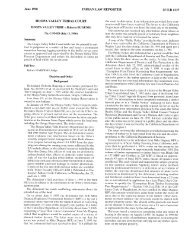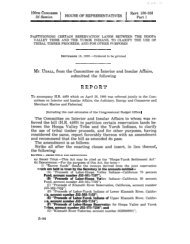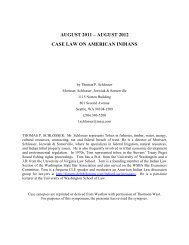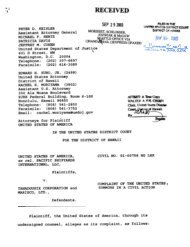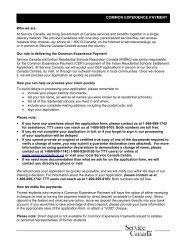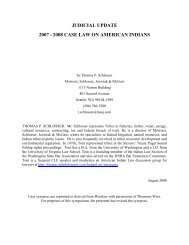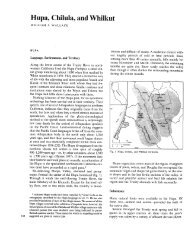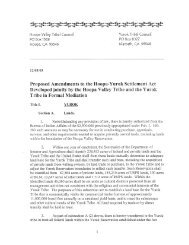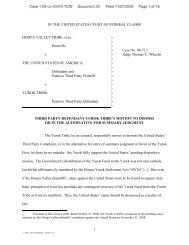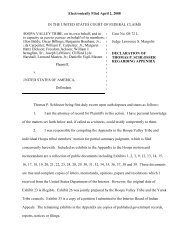Hoopa appendix supporting summary judgment - Schlosser Law Files
Hoopa appendix supporting summary judgment - Schlosser Law Files
Hoopa appendix supporting summary judgment - Schlosser Law Files
Create successful ePaper yourself
Turn your PDF publications into a flip-book with our unique Google optimized e-Paper software.
REPORT TO CONGRESS ON THE HOOPA-YUROK SETTLEPY[ENT ACT’<br />
Tnfrc~diictrnfl<br />
The 1988 <strong>Hoopa</strong>-Yurok Settlement Act divided the joint <strong>Hoopa</strong> Valley Reservation<br />
into separate and unequal parts for the <strong>Hoopa</strong> Valley Tribe and the Yurok Tribe. In the Act,<br />
Congress overturned 25 years of litigation that established that all Indians of the <strong>Hoopa</strong><br />
Valley Reservation, whether or not enrolled in the <strong>Hoopa</strong> Valley Tube, have equal rights to<br />
share in the resources ofthe Reservation. The Act disrupted and cut short the orderly and fair<br />
administration of the federal courts’ <strong>judgment</strong>s in Shrwt v I Jnitecl States and P’ii~’v I Inited<br />
St~iesthat had for the first time in history recognized the equal and per ianent rights of the<br />
Yurok people in the joint <strong>Hoopa</strong> Valley Reservation, part ofthe aboriginal home ofthe Yurok<br />
people. The Act deprived the Yurok Tribe and its members of rights and resources that the<br />
courts had’determined belonged to them as a lawful and constitutional mandate.<br />
Congress contemplated that claims would be brought challenging the constitutionality<br />
under the 5th Amendment ofthe partitioning of the former Joint <strong>Hoopa</strong> Valley Reservation.<br />
25 U.S.C. 0 1300i-11. The Yurok Tribe, along with the Karuk Tribe and a group of<br />
individuals known as the Amnmon plainti~, flied such a claim in 1992, alleging that the<br />
partitioning of the Reservation was a taking ofthe Tribe’s property withoutjust compensation<br />
in violation of the 5th Amendment. This litigation was concluded on March 26, 2001, when<br />
the U.S. Supreme Court refused to review lower court decisions dismissing the Tribe’s claim<br />
on the ground that no tribe or Indian individuals had a property interest in the joint reservation<br />
that was a property interest protected by the Constitution.<br />
The conclusion of this litigation triggers the requirement of the Act that the Secretary<br />
of the interior prepare and submit to Congress a report describing “the final decision in any<br />
claim” brought against the United States which challenged the constitutionality of the Act 25<br />
U.S.C. [1 1300i-1 1(c)(1). The report must include “recommendations of the Secretary for<br />
action by Congress, including but not limited to, any supplemental funding proposals<br />
necessary to implement the terms of [the Act] and any modifications to the resource and<br />
mana~ementauthorities established by [the Act].” 25 U.S.C. 1300i-ll(c)(2). The report is<br />
due 180 days after the entry of “final <strong>judgment</strong>,” or September 22, 2001.<br />
This report contains the recommendations of the Department for legislative proposals<br />
which in our view are required to correct inequities in the Act that Congress either overlooked



